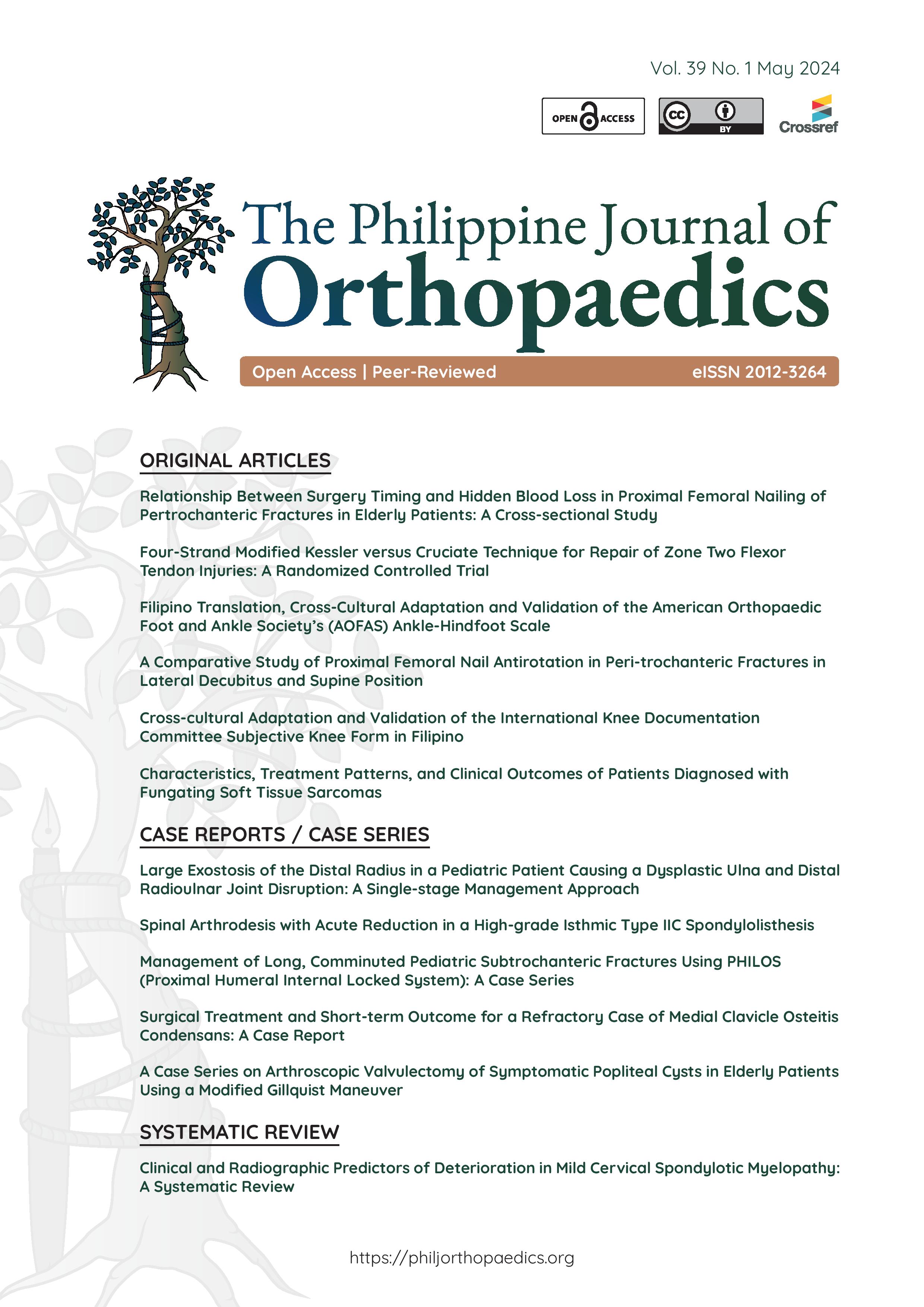Characteristics, Treatment Patterns, and Clinical Outcomes of Patients Diagnosed with Fungating Soft Tissue Sarcomas
Main Article Content
Abstract
Objectives. A fungating soft tissue sarcoma of the extremities (F-ESTS) is a rare clinical presentation with limited literature. This study aims to describe the important clinical characteristics, treatment patterns, and outcomes of twenty patients diagnosed with F-ESTS and treated by a single surgeon at a sarcoma unit.
Methodology. We conducted a retrospective clinical study on twenty F-ESTS patients treated by a single surgeon at a sarcoma unit over 25 years (1993–2018).
Results. The local incidence of F-ESTS was 10.9%. The mean age of patients was 49.2 years old. The most common site of occurrence was the thigh (50%) with an average size of 11.8 cm. Most tumors were deep (65%) and high grade (85%). Liposarcomas were the most common histologic diagnosis (35%). Limb salvage was done in 60% of the patients with 50% requiring reconstructive procedures. Fifteen percent of patients developed complications, 25% had local recurrence, and 65% developed distant metastases. The mean survival for this cohort was 49.2 months. Sixty percent of patients died of disease.
Conclusion. The majority of F-ESTS patients were younger than 65 years old, had deep and high-grade tumors, predominantly liposarcomas, most commonly found in the thigh, and had a history of surgery or biopsy. In the last 10 years, limb salvage surgery has become the treatment of choice even for patients with fungating sarcomas.
Most F-ESTS patients in our study were still able to undergo limb salvage surgery. Local recurrence was seen in five (25%) patients, while thirteen (65%) patients had distant metastases. Twelve (60%) patients had died of disease.
Article Details

This work is licensed under a Creative Commons Attribution 4.0 International License.

This work is licensed under a Creative Commons Attribution 4.0 International License.
References
Mahmoud AMA, Mahmoud M, Charaf A, Moneer MM. The profile of extremity and trunk soft tissue sarcoma in a tertiary referral center. J Egypt Natl Canc Inst. 2017;29(2):89-94. https://pubmed.ncbi.nlm.nih.gov/28462849 https://doi.org/10.1016/j.jnci.2017.03.001
Vodanovich DA, M Choong PF. Soft-tissue sarcomas. Indian J Orthop. 2018;52(1):35–44. https://pubmed.ncbi.nlm.nih.gov/29416168 https://www.ncbi.nlm.nih.gov/pmc/articles/PMC5791230 https://doi.org/10.4103/ortho.IJOrtho_220_17
Wang E, Arbatin J, Dela Rosa T, Punzalan P, De Dios AV. Prognostic factors in non-metastatic extremity soft tissue sarcoma. Musculoskeletal Tumor Unit, UP-PGH. PowerPoint slideshow. Accessed October 30, 2023. Unpublished.
Potter BK, Adams SC, Qadir R, Pitcher JD, Temple HT. Fungating soft tissue sarcomas. Treatment implications and prognostic importance of malignant ulceration. J Bone Joint Surg Am. 2009;91(3):567–74. https://pubmed.ncbi.nlm.nih.gov/19255216 https://doi.org/10.2106/JBJS.H.00071
Parry M, Evans S, Sugath S, Wafa H, Jeys L, Grimer R. Fungation in soft tissue sarcomas is associated with poor survival. Int Orthop. 2017;41(12):2613–8. https://pubmed.ncbi.nlm.nih.gov/28971269 https://doi.org/10.1007/s00264-017-3628-6
Ngan R, Wang E, Porter D, et al. Soft-tissue sarcomas in the Asia-Pacific region: a systematic review. Asian Pac J Cancer Prev. 2013;14(11):6821–32. https://pubmed.ncbi.nlm.nih.gov/24377612 https://doi.org/10.7314/apjcp.2013.14.11.6821
Okajima K, Kobayashi H, Okuma T, et al. Prognosis and surgical outcome of soft tissue sarcoma with malignant fungating wounds. Jpn J Clin Oncol. 2020;51(1):78–84. https://pubmed.ncbi.nlm.nih.gov/33037437 DOI: 10.1093/jjco/hyaa176
Wang EHM, Araneta KTS, Gaston CLL, et al. Unplanned excision of soft tissue sarcomas of the extremities in a low-to-middle-income country. Ann Surg Oncol. 2023;30(6):3681–9. https://pubmed.ncbi.nlm.nih.gov/36800129 https://www.ncbi.nlm.nih.gov/pmc/articles/PMC9936942 DOI: 10.1245/s10434-023-13188-x





